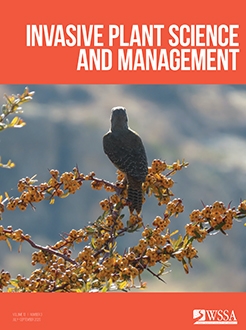Indaziflam, a PRE herbicide option for weed management on rangeland and natural areas, provides long-term control of invasive winter annual grasses (IWAGs). Because indaziflam only provides PRE control of IWAGs, POST herbicides such as glyphosate can be mixed with indaziflam to control germinated IWAG seedlings. Field trials were conducted at three sites on the Colorado Front Range to evaluate glyphosate dose required to provide adequate POST IWAG control and compare long-term downy brome (Bromus tectorum L.), Japanese brome (Bromus arvensis L.), and feral rye (Secale cereale L.) control with indaziflam and imazapic. Two of the three sites were void of desirable species, so species establishment through drill seeding was assessed, while the remnant native plant response was assessed at the third site. Herbicide applications were made March 2014 through April 2015, and two sites were drill seeded with native species 9 mo after herbicide application. Yearly visual control evaluations, biomass of all plant species, and drilled species stand counts were collected. Glyphosate at 474 g ae ha–1 reduced B. tectorum biomass to zero, while glyphosate at 631 g ae ha–1 was needed to reduce biomass to near zero at the S. cereale site. At all three sites, only indaziflam treatments had significant reductions in IWAG biomass compared with the nontreated check at 3 yr after treatment (YAT). By 3 YAT in the drill-seeded sites, cool-season grass frequency ranged from 37% to 69% within indaziflam treatments (73 and 102 g ai ha–1), while imazapic treatments ranged from 0% to 26% cool-season grass frequency. In the site with a remnant native plant community, indaziflam treatments resulted in a 3- to 4-fold increase in native grass biomass. These results indicate that the multiyear IWAG control provided by indaziflam can aid in desirable species reestablishment through drill seeding or response of the remnant plant community.
How to translate text using browser tools
14 July 2020
Evaluating winter annual grass control and native species establishment following applications of indaziflam on rangeland
Shannon L. Clark,
Derek J. Sebastian,
Scott J. Nissen,
James R. Sebastian
ACCESS THE FULL ARTICLE
Bromus arvensis
Bromus tectorum
drill seeding
rangeland restoration
revegetation
Secale cereale






